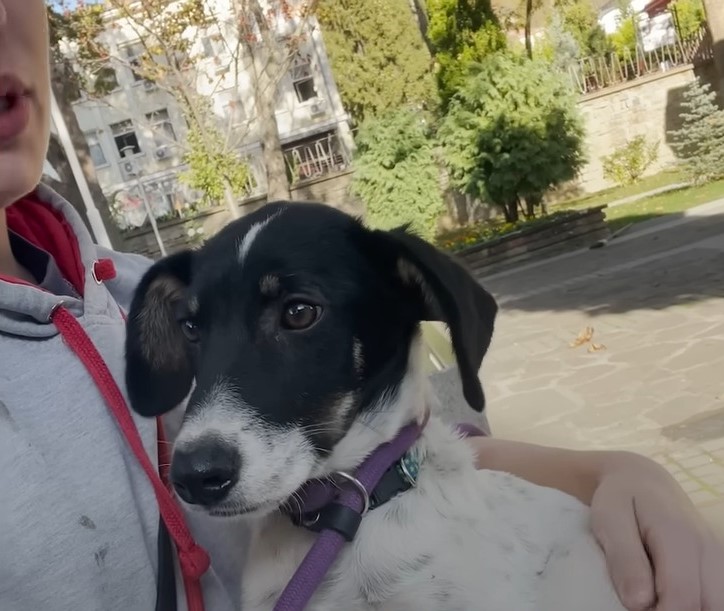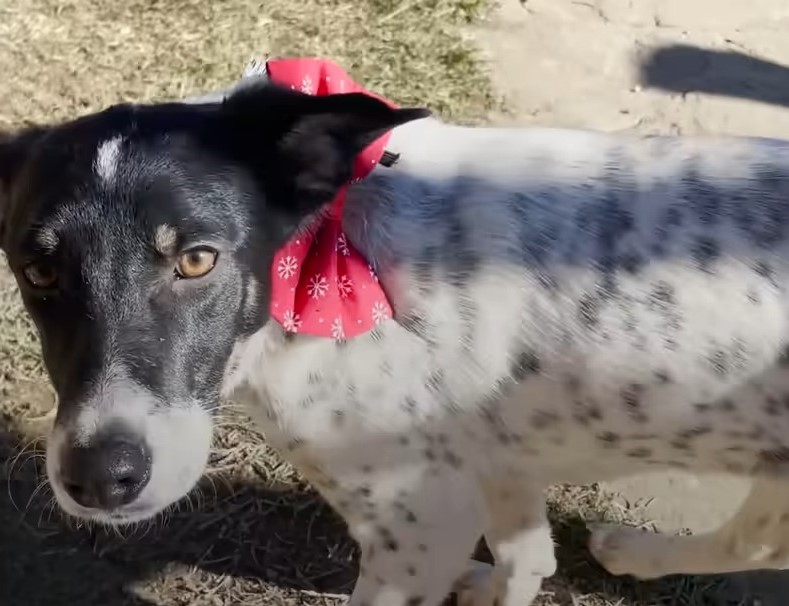It was a very ordinary day when Lauren first found a stray dog alone on the street. Upon first approaching him, she realized something was wrong.
The pup was shivering the whole time. He was seriously terrified of everyone he met, and his new rescuer felt so bad for him.
She did not know how he became so fearful of other people, but it was likely that he was abused by strangers, which is horrifying.
Lauren decided that she was going to do her best to help him recover from his trauma and start his life again.
It Is Going To Take A While

As soon as Lauren transferred the dog, now named Archer, back to the rescue organization, they worked hard to help him. Even with their aid, the pup was still so afraid.
He wouldn’t even look at them, and it was hard to get him to eat anything. When they tried to take him for a walk with a lead-on, he refused.
Lauren told The Dodo: “We don’t know what’s happened to him whilst he’s been by the side of the road.”

She noted that it was not uncommon for people in that town to throw rocks at stray dogs. This was just depressing to hear.
How anyone could do something so horrible to an innocent dog is beyond me. Nevertheless, the pup was safe now, and his rescuers will do their best to help him see they only want to help.
Whenever Lauren would try to hold and cuddle Archer, he didn’t quite know how to react. He was quite uneasy at first.
Archer’s New Personality

However, with time, Archer realized that he enjoyed spending his time with his amazing rescuer.
This is when the big change happened in this dog’s attitude. When he finally realized that he was safe, he relaxed almost instantly.
Whenever they would go for walks, he was incredibly excited and loved spending time with his favourite people.
One of the activities that he really enjoyed, however, was lying in a bed with Lauren and just taking a long nap.
However, his journey was not over yet. His rescuers realized that he was now ready for the next phase in his life.
A New Chance Archer Needed

They took him to a town so they could help him overcome his fear of bigger places. When they did that, Lauren said: “He was completely stiff again, like it was in the early days. He sat on my knee, and he watched the world go by.”
However, despite his fear, it was not all hopeless. The very next time Archer was taken into the same town, his reaction was quite different.
While he was a bit uneasy, he was a lot more confident when walking down the streets, and Lauren was just so proud of him.

After seven months in her care, he changed completely. He was a lot happier and more playful with each passing day.
Even though Lauren just loves him so much, she is also really excited at the prospect that he might finally find a forever home where he could enjoy his life with someone amazing.
She said: “In the shelter, there are so many other dogs who we’ve got to spread our time between, and he deserves to be the center of someone’s universe and have his own happy family.”
Ever wondered what’s behind that joyful tail wagging of your furry companion? Picture this: you walk through the door, and your dog’s tail starts swishing back and forth like a metronome set to happiness. It’s a universal sign of canine communication that speaks volumes without a single bark.
When your dog wags its tail, it’s like a wagging welcome sign, a friendly gesture that can mean a myriad of things. From excitement to curiosity, happiness to nervousness, your pup’s tail is a tell-tale indicator of their emotional state. Understanding this wagging code is like unlocking a secret language between you and your four-legged friend.
The Science Behind Tail Wagging
The Role of Emotions in Tail Movements
Dogs use their tails to communicate various emotions. Whether they’re excited, happy, curious, or nervous, a wagging tail indicates their emotional state. The speed, direction, and height of the wag can give you insights into how your furry friend is feeling. Understanding these cues can help strengthen the bond between you and your dog.
The Brain-Tail Connection
The wagging of a dog’s tail is not just a random movement—it’s deeply connected to their brain activity. Studies have shown that different parts of a dog’s brain control tail wagging based on the emotions they are experiencing. This connection between the brain and tail movement showcases the complexity of canine communication and offers a fascinating glimpse into the inner workings of our loyal companions.
Tail Wagging as Communication
When a dog wags its tail, it’s more than just a happy-go-lucky gesture; it’s their way of talking to you. Dogs use tail wagging as a form of communication to share how they’re feeling.
Interpreting Different Tail Wags
The way your dog wags its tail can convey various emotions. A broad, rapid wag usually means they’re excited or happy. On the other hand, a slow wag could indicate uncertainty or nervousness. Pay attention to the speed and direction of the wag to better understand what your furry friend is trying to tell you.
How Dogs Communicate with Other Dogs
Dogs also communicate with each other through tail movements. A high, stiff wag may signal dominance or aggression, while a low, relaxed wag often signifies friendliness. Understanding these subtle cues can help prevent misunderstandings during dog-to-dog interactions.
What Your Dog’s Tail is Telling You
Next time you see your dog wagging its tail, take a moment to observe. Are they wagging it high or low? Fast or slow? By noting these details, you can decipher their emotional state and respond accordingly. Tail wagging is your pup’s way of opening up to you, so pay attention and strengthen your bond.
The Link Between Tail Wagging and Health
Tail Wagging and Physical Well-being
When your dog wags its tail, it’s not just expressing emotions; it can also indicate aspects of their physical health. Pay attention to the nature of the wagging—whether it’s vigorous, slow, or erratic. A happy and healthy dog will typically have more frequent and energetic tail wags compared to a lethargic or unwell dog. Therefore, monitoring your dog’s tail movements can be a useful indicator of their overall well-being.
Stress Signals in Tail Movements
Dogs communicate stress and anxiety through their tail movements. If you notice your dog exhibiting low, slow tail wags or keeping its tail tucked between its legs, it could be a sign of discomfort or unease. Similarly, abrupt or stiff tail wagging can indicate agitation or stress. Understanding these stress signals can help you provide a supportive environment for your furry friend. Paying attention to these subtle cues can enhance your bond with your dog and ensure their mental and emotional wellness.
Influences on Tail Wagging Behavior
Breed-Specific Tail Wagging Traits
Different dog breeds have distinct tail wagging behaviors. For instance, some breeds may wag their tails in a wide arc, while others may have a more subtle wag. Understanding your dog’s breed-specific tail wagging traits can help you interpret their emotions more accurately. Pay attention to how your dog naturally wags its tail to better comprehend their feelings.
The Impact of Age and Experience
A dog’s age and life experiences can influence how they wag their tail. Younger dogs may exhibit more exuberant wagging, expressing their enthusiasm and curiosity. On the other hand, older dogs might have a calmer wag, reflecting their wisdom and maturity. Additionally, a dog’s past experiences shape their tail wagging behavior; a rescue dog may wag differently than a dog raised in a loving home. Consider your dog’s age and past to decode the messages behind their tail movements.
Tail Wagging in Domestication and Training
How Training Affects Tail Wagging
Training plays a crucial role in refining a dog’s tail wagging behavior. Positive reinforcement techniques during training sessions can enhance a dog’s ability to express happiness and positivity through their wag. Dogs trained with patience and consistency tend to have more controlled and purposeful tail movements. It’s essential to reinforce positive behaviors during training to encourage a more balanced and amicable wagging pattern in your furry companion.
Understanding and Responding to Your Dog’s Tail
To understand your dog’s tail language better, pay close attention to the context in which the wagging occurs. A relaxed and wide wag often signifies a friendly and happy demeanor, while a stiff and rapid wag may indicate agitation or potential aggression. Responding appropriately to your dog’s tail signals by providing comfort or addressing any underlying stressors can strengthen your bond and promote a sense of security for your canine companion.
Conclusion
Understanding why a dog wags its tail goes beyond a simple physical gesture. It’s their way of expressing a range of emotions and needs, from joy and excitement to anxiety and aggression. By paying attention to the nuances of their tail movements, you can deepen your bond with your furry friend. Training plays a crucial role in refining a dog’s wagging behavior, allowing them to communicate more effectively with you and other dogs. Responding appropriately to their tail signals not only strengthens your relationship but also ensures their emotional well-being. So, next time your pup wags its tail, take a moment to decode the message they’re sending—it’s their unique way of talking to you.
Frequently Asked Questions
What emotions can a dog convey through tail wagging?
A dog can convey emotions like happiness, excitement, and nervousness through tail wagging.
How can the speed, direction, and height of a dog’s wag provide insights into their emotional state?
The speed, direction, and height of a wag can provide insights into a dog’s emotional state by indicating their level of excitement, happiness, or anxiety.
How do dogs use tail movements to communicate with each other?
Dogs use tail movements to communicate with each other, with different wags indicating dominance, aggression, or friendliness.
How can training impact a dog’s tail wagging behavior?
Training can refine a dog’s tail wagging patterns, and positive reinforcement techniques during training sessions can improve a dog’s ability to express happiness and positivity through their wag.
What should owners pay attention to in a dog’s tail language?
Owners should pay attention to the context in which the wagging occurs. A relaxed and wide wag signifies a friendly demeanor, while a stiff and rapid wag may indicate agitation or aggression.
[no_toc]

Hey there, I’m Janet Brooks, a dog-loving student from California. I’m all about helping pups in need, especially those without homes. Me and my awesome friends work together to give shelter and love to stray dogs. Oh, and I also write blogs about dogs to share helpful info.